Household grocery budgets still face tremendous pressure as supermarket prices remained elevated at 11.8 percent, and rose 0.2 percent month over month.
The Consumer Price Index (CPI) report showed that many kitchen staples continue to be much higher than they were a year ago. Other common food items are rising or falling at a sluggish pace.
The cost of eggs, for example, has captured national attention, with prices skyrocketing 59.9 percent year over year last month. From November to December 2022, egg prices advanced 11.1 percent.
Egg farmers have faced a trifecta of problems over the last year.
The contagious and lethal highly pathogenic avian influenza (HPAI) has decimated supplies. When birds contract the avian flu, they must be slaughtered. As a result, about 43 million egg-laying hens have been killed. Experts say it’s the deadliest outbreak in the nation’s history.

The sizable increase in animal feed has also added to input costs. Prices have eased from a year ago, but the latest data show that feed is up more than 4 percent.
Lettuce is another food item that has had a significant cost increase from a year ago, with prices rising nearly 25 percent.
One of the chief reasons for that has been the decline in milk production. Despite a substantial increase in production from February to May 2022, output tumbled nearly 7 percent from June to November 2022.
As with eggs, the cost of feed and persistent labor shortages has made buying and maintaining cows much more expensive for farmers in the last couple of years.
In addition, according to the U.S. Department of Agriculture (USDA), climate factors, such as floods and droughts, have “weighed on productivity growth.”
How Are Consumers Coping?
Looking ahead to next year, the increase in food prices is expected to slow to 7.6 percent, according to the Federal Reserve Bank of New York’s Survey of Consumer Expectations. If accurate, it'd be the lowest level since January 2022.At a time when food prices are going through the roof, consumers are struggling to put groceries on the table.
“Some families’ food budgets have been stretched so thin that a quarter of them only buy items when they are on sale. It is not hyperbole to say that many Americans are living worse than their grandparents did in terms of food security.”
When real wages (inflation-adjusted) have been down for a record 21 consecutive months, effectively destroying thousands of dollars in purchasing power for the typical U.S. family, it might mean more affordability difficulties at the local supermarket.
While the U.S. annual inflation rate slowed to 6.5 percent in December 2022, Peter Earle, an economist at the American Institute for Economic Research, warned that the rate will likely decrease slowly.
“One of the big fears you always have when you have an outbreak of inflation, and when we haven’t had one for 40 years, is that it rises pretty quickly and pretty easily gets sticky. And it gets sort of persistent and stubborn on the way down,” Earle told The Epoch Times. “Coming down, it’s gonna be a little bit slower.”
That might be the case for grocery bills in 2023.





